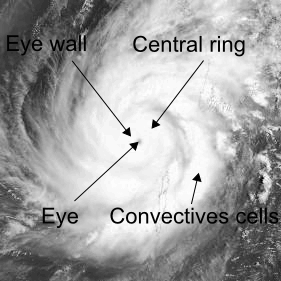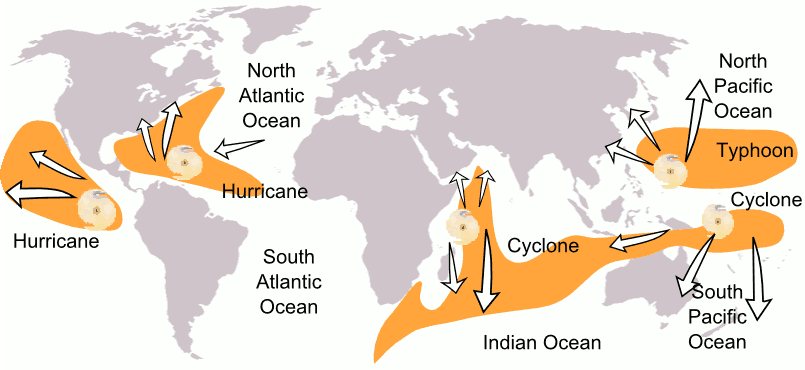Hurricanes, a destructive force
The worldwide volume of annual economic loss caused by mind storms has grown from 2 billion USD in the 1960s to 3.4 billion USD in the 1980s, and to 20.2 billion USD in the first three years of the 1990s.
Global warming and climatic disturbances are not the only elements to blame for the rising frequency of these phenomena.
Definition
The word cyclone stems from the Greek word kuklos, which means circle. It refers to an atmospheric disturbance originating from the converging and ascending gyratory movement of the wind around a low-pressure area where it has violently been driven from a high-pressure area.
Depression : the source of the hurricane
A big depression caught between two anti-cyclones reinforces wind movements blowing in opposite directions. These winds converge towards the center of the depression. They blow clockwise in the northern hemisphere and otherwise in the southern hemisphere. It is the Coriolis force, triggered by the earth rotation, which is the source of this whirlwind. This force is nil on the equator, hence, the absence cyclonal events in this area.
The cyclone evolution
Initially, a cyclone starts out as a cloudy and rainy mass associated to a low-pressure area. It builds up in high-sea zones where temperatures are above 27°C in depths exceeding 60 meters.
Under the effect of hot humidity (moist), stemming from intensive evaporation, the phenomenon picks up as it sweeps along an unpredictable path. It loses strength in a progressive way as it penetrates inland or when it flies over cold waters.
Dictionary
- The word cyclone was first used in 1845 by Paddington of the Calcutta observatory. It refers to what used to be called whirlwind or hurricane.
- The word hurricane is a transliteration of the Hispano-Caribbean word Huracon, and ouragan is nothing else than the frenchfried form of the word.
- Cyclones in Southern East Asia are called typhoon.
Features
 The central ring of the hurricane: the most active zone with torrential rain and violent whirlwinds.
The central ring of the hurricane: the most active zone with torrential rain and violent whirlwinds.
The eye of the cyclone: a forty to a hundred kilometer diameter, lull area with clear sky and light wind.
Eye wall: doline surrounded by 14 000 to 18 000-metre-high cloud ring. It marks the belt of the strongest winds and the heaviest downpours.
Their Christian names
Hurricanes used to have female names. But women lib movements protested and deemed the tradition discriminatory.
Since 1979, hurricanes have had male names in pair years and female names in impair years using six alphabetical lists that are periodically reconducted; a purely formal decision that can in no case change either the lethal power of hurricanes or their itinerary.
Cycles
Tropical disturbances occur only during the year's hot season when conditions are the most favourable, especially hot moisture which accounts for the cyclone's force. In Australia and Madagascar, the cyclonic season starts from November to April. In the Caribbean and in Florida, the official season of hurricanes extends from June 1 to November 30. Ten to eleven hurricanes have been reported, but since 1995, their frequency has risen to 12 and 14 cyclones per year. Last August, four hurricanes have been registered on the American coasts.
Intensity of tropical disturbances
The evolution of the initial disturbance depends on the regional atmospheric conditions. It can rise from the status of a tropical depression (with wind gusts between 37 and 60 km per hour), to a tropical storm (with wind gusts between 63 to 117 km per hour). Beyond the already-mentioned scales, the initial disturbance builds up to become an intense or very intense tropical cyclone.
The reference used to measure the intensity of disturbances is the Saffir Simpson scale which comprises five grades.
The Saffir Simpson scale
| Category | Label | Wind speed | Effects |
|---|---|---|---|
1 | Tropical cyclone | 118 to 153 km/h (violent wind) | Minor damages: dwellings, trees and some crops |
2 | Tropical cyclone | 154 to 177 km/h (destructive wind) | Significant damages: dwellings, trees. Heavy damages to certain crops, power failure risks. |
3 | Intense tropical cyclone | 178 to 209 km/h (very destructive wind) | Heavy damages to dwellings. Power failures. |
4 | Very intense tropical cyclone | 210 àto249 km/h (very destructive wind) | Considerable damages to infrastructures, destruction of dwellings and crops. Hazardous debris from airlifted objects. Several power stoppages. |
5 | Very intense tropical cyclone | > 250 km/h (very destructive wind) | Massive destructions of dwellings, infrastructures and crops. Extreme danger from flying debris. |
Range and damage
The hurricane's intensity peaks in the eyewall area on a radius of 100 km. Its effects slow down while remaining direct on a 200 km radius. Starting from 400 km, no dangerous effects can be observed.
The damage caused by the passage of a hurricane is of three levels:- Violent gusts likely to destroy infrastructures, buildings, vegetations and crops.
- Heavy downpours resulting in land slide paralysing road and railroad traffic.
- Successive storms followed by sea water floods resulting from high waves.
Cyclonal areas
Hurricanes grow and pick up in warm oceanic areas where Coriolis force is high. The latter provides the hurricane with its spiral form while maintaining the atmospheric low pressures of the disturbance.

List of the most expensive and murderous hurricanes since 1975
in millions USD| Country | Date | Event | Insured damages1 | Victims2 |
|---|---|---|---|---|
Bangladesh | 19/04/1976 | Tropical Cyclone Gorky | 3 | 138 000 |
India | 20/11/1977 | Cyclone in Bengali gulf | _ | 10 000 |
USA | 29/08/1979 | Hurricane Frederic | 1 899 | _ |
Bangladesh | 25/05/1985 | Bengal | _ | 10 000 |
Porto Rico, USA | 15/09/1989 | Hurricane Hugo | 6 203 | 71 |
Philippines | 05/11/1991 | Typhoons Thelma and Uring | _ | 5 300 |
Japan | 27/09/1991 | Typhoon Mireille | 7 598 | 51 |
Bahamas, USA | 23/08/1992 | Hurricane Andrew | 20 900 | 43 |
USA , North Pacific | 11/09/1992 | Hurricane Iniki | 2 090 | 4 |
Caraïbes | 03/09/1995 | Hurricane Luis | 1 804 | 116 |
Mexico, USA | 01/10/1995 | Hurricane Opal | 2 526 | 59 |
USA | 05/09/1996 | Hurricane Fran | 1 870 | 39 |
Vietnam | 01/11/1997 | Typhon Linda | 6 | 3 840 |
Hondura | 22/10/1998 | Hurricane Mitch in Central America | 562 | 9 000 |
Caraïbes, USA | 20/09/1998 | Hurricane Georges | 3 969 | 600 |
Jamaïca | 10/09/1998 | Hurricane Gilbert | 1 694 | 350 |
India, Bangladesh | 29/10/1999 | Cyclone 05B devastates Orissa State | 110 | 15 000 |
Japan | 22/09/1999 | Typhoon Bart (south of the country) | 4 445 | 26 |
Bahamas, USA | 10/09/1999 | Hurricane Floyd, rains and flood | 2 597 | 70 |
USA , Canada | 18/09/2003 | Hurricane Isabel | 1 685 | 30 |
USA | 02/05/2003 | Storms, tornado and hail | 3 205 | 45 |
South Korea | 07/09/2003 | Typhoon Maemi, gusty wind | 504 | 131 |
Florida, USA | 13/08/2004 | Hurricane Charley | 10 000* | 117* |
Florida, USA | 05/09/2004 | Hurricane Frances | 5 000* | ND |
Florida, Alabama | 16/09/2004 | Hurricane Ivan | 10 000* | 108* |
Haiti, Floride | 18/09/2004 | Hurricane Jeanne | ND | 2 413* |
